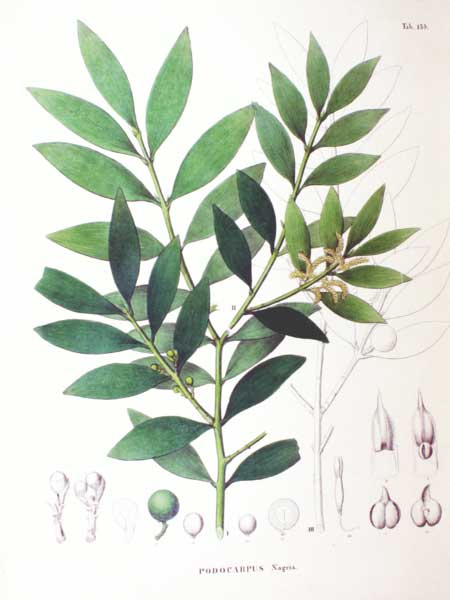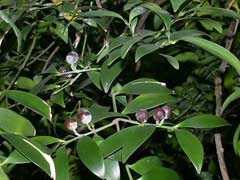 |
|
http://commons.wikimedia.org/wiki/File:Podocarpus_nageia_SZ137.png |
 |
| http://commons.wikimedia.org/wiki/User:Keisotyo |
Translate this page:
Summary
Bloom Color: Yellow. Main Bloom Time: Early spring, Late spring, Mid spring. Form: Oval, Pyramidal, Upright or erect.
Physical Characteristics

 Nageia nagi is an evergreen Tree growing to 25 m (82ft 0in) at a medium rate.
Nageia nagi is an evergreen Tree growing to 25 m (82ft 0in) at a medium rate.
See above for USDA hardiness. It is hardy to UK zone 8. It is in leaf all year, in flower from March to May, and the seeds ripen from September to November. The species is dioecious (individual flowers are either male or female, but only one sex is to be found on any one plant so both male and female plants must be grown if seed is required). and is pollinated by Wind. The plant is not self-fertile.
Suitable for: light (sandy), medium (loamy) and heavy (clay) soils. Suitable pH: mildly acid, neutral and basic (mildly alkaline) soils. It can grow in semi-shade (light woodland) or no shade. It prefers moist soil.
UK Hardiness Map
US Hardiness Map
Synonyms
Decussocarpus nagi. Podocarpus nagi. (Thunb.)Zoll.&Moritz.
Plant Habitats
Woodland Garden Canopy; Secondary;
Edible Uses
Edible Parts: Leaves Oil Oil
Edible Uses: Oil Oil
Young leaves are occasionally parboiled and eaten[183]. The seeds yield an edible oil which is also used in industry[266].
References More on Edible Uses
Medicinal Uses
Plants For A Future can not take any responsibility for any adverse effects from the use of plants. Always seek advice from a professional before using a plant medicinally.
None known
References More on Medicinal Uses
The Bookshop: Edible Plant Books
Our Latest books on Perennial Plants For Food Forests and Permaculture Gardens in paperback or digital formats.

Edible Tropical Plants
Food Forest Plants for Hotter Conditions: 250+ Plants For Tropical Food Forests & Permaculture Gardens.
More

Edible Temperate Plants
Plants for Your Food Forest: 500 Plants for Temperate Food Forests & Permaculture Gardens.
More

More Books
PFAF have eight books available in paperback and digital formats. Browse the shop for more information.
Shop Now
Other Uses
Oil Oil Wood
The seeds yield an edible oil which is also used in industry[266]. The wood is used for constructing houses and bridges, making furniture, utensils, and handicraft articles[266].
Special Uses
References More on Other Uses
Cultivation details
Landscape Uses:Border, Screen, Specimen, Street tree. This species is hardy to about -20°c, but plants require a 4 month hot humid summer for satisfactory development[200]. Best grown in a warm continental climate[200]. Dioecious, male and female plants must be grown if seed is required. Special Features:
Attractive foliage, Not North American native, Inconspicuous flowers or blooms.
References Carbon Farming Information and Carbon Sequestration Information
Temperature Converter
Type a value in the Celsius field to convert the value to Fahrenheit:
Fahrenheit:
The PFAF Bookshop
Plants For A Future have a number of books available in paperback and digital form. Book titles include Edible Plants, Edible Perennials, Edible Trees,Edible Shrubs, Woodland Gardening, and Temperate Food Forest Plants. Our new book is Food Forest Plants For Hotter Conditions (Tropical and Sub-Tropical).
Shop Now
Plant Propagation
Seed - can be sown at any time of the year in a sandy soil in a warm greenhouse, though it is probably best sown as soon as it is ripe[1]. When they are large enough to handle, prick the seedlings out into individual pots and grow them on in the greenhouse for at least their first winter. Plant them out into their permanent positions in late spring or early summer, after the last expected frosts. Cuttings of half-ripe terminal shoots, 5 - 10cm long, July/August in a frame[78].
Other Names
If available other names are mentioned here
Native Range
TEMPERATE ASIA: China (Fujian Sheng, Guangdong Sheng, Guangxi Zhuangzu Zizhiqu, Hunan Sheng, Jiangxi Sheng, Sichuan Sheng, Zhejiang Sheng), Japan (Honshu (west), Kyushu, Ryukyu Islands, Shikoku), Taiwan
Weed Potential
Right plant wrong place. We are currently updating this section.
Please note that a plant may be invasive in one area but may not in your area so it's worth checking.
Conservation Status
IUCN Red List of Threatened Plants Status :

Growth: S = slow M = medium F = fast. Soil: L = light (sandy) M = medium H = heavy (clay). pH: A = acid N = neutral B = basic (alkaline). Shade: F = full shade S = semi-shade N = no shade. Moisture: D = dry M = Moist We = wet Wa = water.
Now available:
Food Forest Plants for Mediterranean Conditions
350+ Perennial Plants For Mediterranean and Drier Food Forests and Permaculture Gardens.
[Paperback and eBook]
This is the third in Plants For A Future's series of plant guides for food forests tailored to
specific climate zones. Following volumes on temperate and tropical ecosystems, this book focuses
on species suited to Mediterranean conditions—regions with hot, dry summers and cool, wet winters,
often facing the added challenge of climate change.
Read More
Expert comment
Author
(Thunb.)Kuntze.
Botanical References
58200266
Links / References
For a list of references used on this page please go here
Readers comment
© 2010, Plants For A Future. Plants For A Future is a charitable company limited by guarantee, registered in England and Wales. Charity No. 1057719, Company No. 3204567.